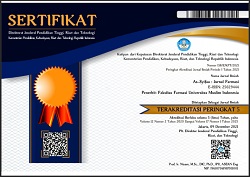UJI EFEK EPITELISASI EKSTRAK BATANG WOLE WOE ASAL KABUPATEN HALMAHERA TENGAH TERHADAP PENYEMBUHAN LUKA BAKAR PADA TIKUS
Abstract
Keywords
Full Text:
PDF (Bahasa Indonesia)References
Demilew W, Adinew GM, Asrade S. Evaluation of the Wound Healing Activity of the Crude Extract of Leaves of Acanthus polystachyus Delile (Acanthaceae). Evidence-Based Complementary and Alternative Medicine. 2018; 2018:1–9
Handayani F, Siswanto E, Pangesti LAT. Uji Aktivitas Ekstrak Etanol Gambir (Uncaria gambir Roxb.) Terhadap Penyembuhan Luka Bakar Pada Kulit Punggung Mencit Putih Jantan (Mus musculus). Jurnal Ilmiah Manuntung. 2017; 1(2):133–139
Singer AJ, Boyce ST. Burn Wound Healing and Tissue Engineering. J Burn Care Res. 2017; 38(3): e605–e613
Prasetyo S. Konsep Dan Proses Keperawatan Nyeri. Yogyakarta: Graha Ilmu. 2010
Kemenkes RI. Suplemen I Farmakope Herbal Indonesia. Jakarta: Kementerian Kesehatan Republik Indonesia. 2010
Rusdi M, Hasan T, Ardillah A, Evianti E. Perbandingan Metode Ekstraksi Terhadap Kadar Flavonoid Total Dan Aktivitas Antioksidan Batang Boehmeria virgata. ad-Dawaa’ Journal of Pharmaceutical Sciences. 2018; 1(1):16–24.
Rahman S, Kosman R, Mukrima I. Efek Ekstrak Etanol Daun Awar-Awar (Ficus septica Burm. F) Terhadap Kemampuan Epitelisasi Pada Tikus (Rattus novergicus). Bionature. 2013; 14(2):112–116.
Wibawani L, Wahyuni ES, Utami YW. Pengaruh Pemberian Ekstrak Etanol Daun Melati (Jasminum sambac L. Ait) Secara Topikal Terhadap Peningkatan Kontraksi Luka Bakar Derajat II A Pada Tikus Putih (Rattus norvegicus) Galur Wistar. Majalah Kesehatan FKUB. 2015; 2(4):196–206
Dewatisari WF, Rumiyanti L, Rakhmawati I. Rendemen Dan Skrining Fitokimia Pada Ekstrak Daun Sanseviera Sp. Jurnal Penelitian Pertanian Terapan. 2018; 17(3):197–202
Simaremare ES. Skrining Fitokimia Ekstrak Etanol Daun Gatal (Laportea decumana (Roxb.) Wedd). Jurnal Pharmacy. 2014; 11(1):98–107
Zulfiah Z. Uji Toksisitas Ekstrak Daun Pletekan (Ruellia tuberosa L) Dengan Pelarut Etanol dan N - Heksan Menggunakan Metode Brine Shrimp Lethality Test (BSLT). Jurnal Farmasi Sandi Karsa. 2020; 6(1):5–11
Prabakti Y. Perbedaan Jumlah Fibroblas Di Sekitar Luka Insisi Pada Tikus Yang Diberi Infiltrasi Penghilang Nyeri Levobupivakain Dan Yang Tidak Diberi Levobupivakain (Tesis). Semarang: Universitas Diponegoro. 2005
Khotimah SN, Muhtadi A. Review Artikel: Beberapa Tumbuhan Yang Mengandung Senyawa Aktif Antiinflamasi. Farmaka. 2016; 14(2):28–40
Kulsum U, Hendari R, Chumaeroh S. Pengaruh Pemberian Gel Kombinasi Ekstrak Getah Pepaya (Carica papaya L) dan Ekstrak Daging Lidah Buaya (Aloe vera) Terhadap Proses Penyembuhan Ulkus Traumatikus Pada Male Wistar Rats Yang Menderita Diabetes Melitus. ODONTO: Dental Journal. 2015; 2(1):41–46
DOI: https://doi.org/10.56711/jifa.v14i1.792
Refbacks
- There are currently no refbacks.
Indexed by:
ISSN: 2085-4714 | e-ISSN: 2502-9444
Editor's Address:
Faculty of Pharmacy, Univeristas Muslim Indonesia
2nd Campus of UMI: Jl. Urip Sumoharjo km. 5 , Makassar, South Sulawesi, Indonesia
E-mail: jurnal.farmasi@umi.ac.id















